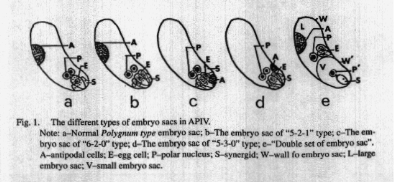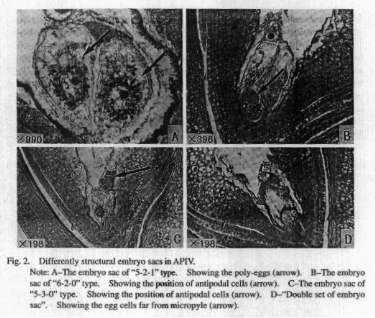Y.G. Lu and X.D. Liu
Plant Molecular Breeding Research Center, South China Agriculture
University, Guangzhou, China
Many mutants for floral development have been found and intensively
studied in higher plants. The most useful information from these studies
is from the model plant Arabidopsis thaliana. Rice has a highly specialized
floral structure. Each embryo sac has only one egg cell. A spontaneous
mutant, polyembryonic rice APIV, was found in which there were more than
one egg cells in embryo sac, in some florets. The number of egg cells was
different among different embryo sacs. In this poly-egg apparatus embryo
sac, three eggs were in majority. They could be further divided into three
types, namely, “5-2-1” type (there were three eggs and two synergids in
the micropyle end, two polar nuclei above the eggs, and one group of antipodals
in the chalazal end (Fig. 1-b and Fig. 2-A), “6-2-0” type (there were three
eggs, two synergids, and one group of antipodals in the micropyle end,
two polar nuclei above the eggs (Fig. 1-c and Fig. 2-B), and “5-3-0” type
(there were three eggs and two synergids in the micropyle end, two polar-nuclei
and one group of antipodals above eggs (Fig. l-d and Fig. 2-C), based on
the whole structure of embryo sac. Besides the poly-egg apparatus embryo
sacs, a new variant embryo sac, referred to as “double set of embryo sac”,
was also found in APIV. There were egg cells far from micropylar end in
the “double set of embryo sac” (Fig. 1-e and Fig. 2-D). According to the
genetic analysis, gametophytic genotypes, rather than sporophytic ones
probably controlled the production of poly-eggs. Genetic polymorphism for
the structure of embryo sac was found in a single-panicle of APIV. Fertilization
and development of the poly-egg apparatus resulted in polyembryony in APIV.
It is considered that APIV is a useful material for molecular study of
the development of female gametophyte in rice.
|

